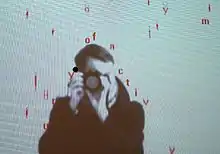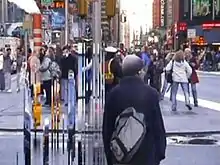Camille Utterback
Camille Utterback (born 1970 in Bloomington, Indiana) is an interactive installation artist. Initially trained as a painter, her work is at the intersection of painting and interactive art.
Camille Utterback | |
|---|---|
| Born | 1970 Bloomington, Indiana |
| Nationality | American |
| Alma mater | Williams College, New York University |
| Known for | Installation Art |
Biography

Utterback received her undergraduate degree from Williams College and her master's degree from the Interactive Telecommunications Program at New York University's Tisch School of the Arts. She is currently an Assistant Professor of the Art and Art History Department at Stanford University and lives in San Francisco, California.
Artwork

Examples of her work include Text Rain (1999),[1][2] created in collaboration with Romy Achituv, in which participants use their bodies to lift and play with falling letters projected on a wall, and Shifting Times (2007),[3] a public installation in San Jose, California that creates interactive projects based on the movements of pedestrians. Helen Lessick describes the latter as a "blending screens of twentieth and twenty-first century San José" in which the "images split and weave, shift between color and black and white, invoking loss and possibility, site and memory." [4]
Utterback says that she is interested in getting people to “think about the difference between something conceptual and something physical” and to “make a hypothesis, and then test it with their bodies.”[5]
Her work has been exhibited at the New Museum of Contemporary Art (New York), the Museum of the Moving Image (New York), Smithsonian American Art Museum (Washington, D.C.)[6] GAFFTA (San Francisco), the Ars Electronica Center (Linz, Austria) and the NTT InterCommunication Center (Tokyo, Japan).
Utterback created an installation called Precarious for the National Portrait Gallery exhibition Black Out: Silhouettes Then and Now, which opened in May, 2018.[7][8]
Awards
She has received several grants and awards including the Rockefeller Foundation New Media Fellowship and the Transmediale International Media Art Festival Award[9] and, in 2009, a "genius award" from the John D. and Catherine T. MacArthur Foundation.[10] Utterback has taught media art at Parsons School of Design,[11] and the Interactive Telecommunications Program at New York University.
Sources
- Christiane Paul (2003). Digital Art (World of Art series). London: Thames & Hudson. ISBN 0-500-20367-9.
- Jeffrey Shaw and Peter Weibel, eds. (2003). "Future Cinema: The Cinematic Imaginary After Film" MIT Press, Cambridge, MA. ISBN 0-262-69286-4.
- Artist's website
See also
- Interactive art
- Surveillance art
- !Women Art Revolution - Utterback, among others, was interviewed for this film[12]
References
- Anon (2018). "Artist, Curator & Critic Interviews". !Women Art Revolution - Spotlight at Stanford. Archived from the original on August 23, 2018. Retrieved August 23, 2018.CS1 maint: ref=harv (link)
- Paul, Christiane (2003). Digital Art (World of Art series). London: Thames & Hudson. ISBN 0-500-20367-9.
- http://www.camilleutterback.com/textrain.html
- http://camilleutterback.com/projects/shifting-time-san-jose/
- Lessick, Helen (Spring–Summer 2011). "Beta Test: Innovation in administration at San Jose, California's Norman Y. Mineta Airport". Public Art Review. 2. 1 (44): 55.
- Klein, Julia M. (2009-03-17). "Art Installations Find Fertile Ground in Science Centers". The New York Times. ISSN 0362-4331. Retrieved 2015-07-25.
- "Text Rain". Smithsonian American Art Museum. Retrieved 25 July 2015.
- FelderS (2018-05-31). "Black Out: Silhouettes Then and Now". npg.si.edu. Retrieved 2019-03-01.
- Asma, Naeem (2018). Black out : silhouettes then and now. Knipe, Penley,, Nemerov, Alexander,, Shaw, Gwendolyn DuBois, 1968-, Verplanck, Anne A.,, Princeton University Press,, National Portrait Gallery (Smithsonian Institution). Princeton, New Jersey. ISBN 978-0691180588. OCLC 1004947475.
- "Camille Utterback Bio". Camille Utterback. Retrieved 25 July 2015.
- Harmanci, Reyhan (2010-08-19). "For Digital Artists, Apps Provide New Palette". The New York Times. Retrieved 25 July 2015.
- "Camille Utterback Vitae". Camille Utterback. Retrieved 25 July 2015.
- Anon 2018
External links